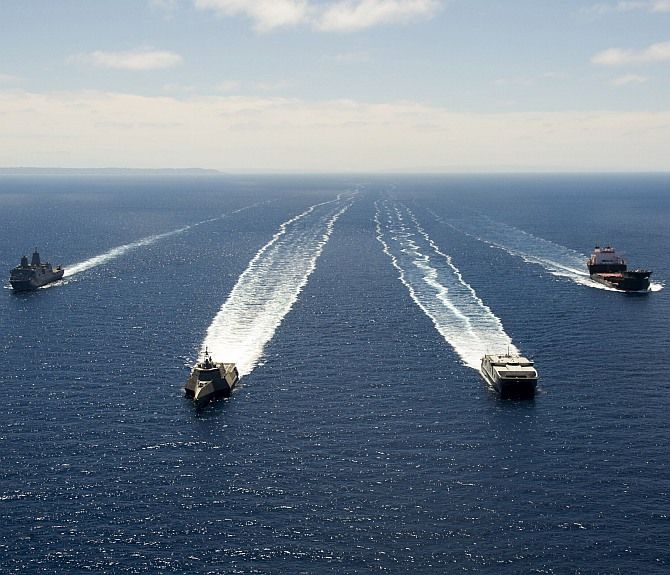 In the lead up to this week Indo-US Strategic Dialogue, for which United States Secretary of State, John Kerry, will be coming to Delhi, the Indo-US defence engagement is even more intense than usual.
In the lead up to this week Indo-US Strategic Dialogue, for which United States Secretary of State, John Kerry, will be coming to Delhi, the Indo-US defence engagement is even more intense than usual.
On Tuesday, an American nuclear-powered aircraft carrier, USS George Washington, will link up for the final phase of Exercise Malabar in the Western Pacific. This is a sophisticated, weeklong naval exercise involving the US and Indian navies and the Japanese Maritime Self Defence Force, as Japan's pacifist constitution refers to what is actually one of Asia's most powerful navies.
How the 18th Malabar exercise, which began last Thursday, is an annual highlight of the US-India naval engagement that was first held in 1992. Since then, it has grown in sophistication, scope and training value. The participation of other regional powers, such as Japan this year, has made Malabar into a statement of India's strategic intent in the Asia-Pacific.
For More Defence News, CLICK HERE
Meanwhile, since July 1, another Indian warship -- the frigate, INS Sahyadri -- has been participating in a month-long, multinational exercise off Hawaii, organised by the US Pacific Command. The Rim of the Pacific 2014 as the high-profile exercise is called, features 22 navies, including those of the US, China, France and the United Kingdom. India is participating for the first time.
Like the inclusion of Japan in Malabar, India's participation in RIMPAC 2014 signals a more assertive Indian approach to the Asia-Pacific. For years, the United Progressive Alliance government dithered over participating in RIMPAC, worrying that Beijing would see this as unfriendly. Even after China's navy decided to participate in RIMPAC 2014, former defence minister, A K Antony, trod cautiously.
The UPA's caution stemmed partly from 2007, when the participation of 25 warships from India, the US, Japan, Australia and Singapore in Exercise Malabar elicited heated protests from the Left Front and the apparent ire of China.
When the US PACOM commander, Admiral Robert Locklear, visited New Delhi last year to urge, among other things, India's participation in RIMPAC 2014, Antony rebuffed a meeting request. Locklear only got to meet the defence secretary and the air force chief.
Only in its last months in government did Antony clear India's participation in RIMPAC, and Japan's participation in Malabar. The Indian warships participating in Malabar 2014 include the destroyer, INS Ranvijay; a frigate INS Shivalik and a fleet tanker, INS Shakti.
Japan has fielded two destroyers, the Kurama and Ashigara, a P3C Orion maritime reconnaissance aircraft, and is showing off a US-2 amphibious aircraft that Japanese company, ShinMaywa, hopes to sell the Indian Navy.
The US navy has sent a Ticonderoga-class destroyer, USS Shiloh; Arleigh Burke-class destroyer, USS John S McCain, and a nuclear-powered attack submarine, USS Columbus. The arrival on Tuesday of USS George Washington will allow the exercise to incorporate a major air dimension.
The first three days of the exercise constituted the "harbour phase", where the three navies tied up joint operating procedures at the Japanese naval base of Sasebo. On Saturday, the warships sailed out to sea and began actually operating together.
The US does more joint military training with India than with any other country. In the "Yudh Abhyas" exercise each year, the two armies train together for "counter-terrorism" missions that are similar to what could some day be a live mission along the India-Pakistan border. The two countries also train jointly for amphibious operations in Exercise Shatrujeet.
The two air forces train together extensively in the "Cope India" and "Cope Thunder" exercises. The IAF participated in 2008 in the highly regarded American "Red Flag" exercise, which is reputed to provide the world's most realistic combat training. The IAF was to participate again in Red Flag 2013, but the exercise was cancelled due to cuts in the US defence budget.
Senior Indian military officers say that US-India exercises like Malabar allow both navies to jointly develop operational doctrines for platforms like the Boeing P8I maritime aircraft, which both are just inducting into service.
The on-going military exercises will be followed by high-level political exchanges, with US Secretary of State John Kerry arriving this week for the fourth US-India Strategic Dialogue, an annual feature of the relationship since 2010. In early August, Defence Secretary Chuck Hagel will visit India. In September, when Prime Minister Narendra Modi travels to the US for the United Nations General Assembly annual meeting, he is likely to have his first meeting with US President Barack Obama.












 © 2025
© 2025